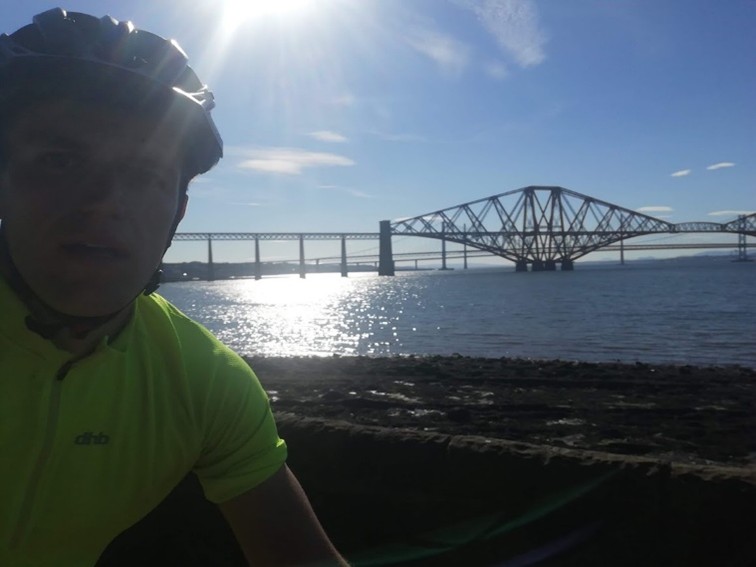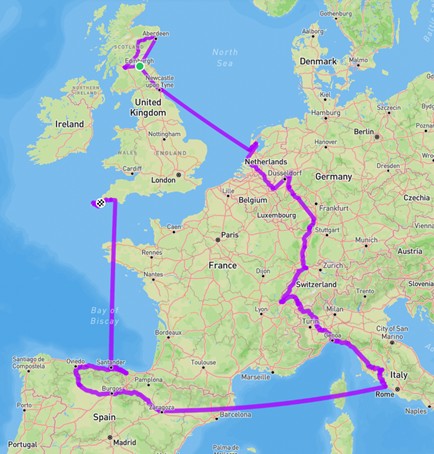Come along for the ride!
Taking inspiration from the Giro d’Italia, this first Giro de Geothermal blog post (out of eight) will bring you along with me, Dave Walls, on my five-week bicycle tour spanning 3600 km through nine of Europe’s best geothermal “hot-spots”. The trip promises to take you through some remarkable climbs in the Alps, scorching hot summer days in the saddle, and *spoilers* maybe even the famous “Maglia Rosa” (pink jersey).
Why geothermal?
A high school trip to Iceland had me mesmerised by geothermal energy – using the heat generated from the Earth for generating power and/ or heat/ cooling. The dramatic steam rising up on the horizon from alien looking boreholes and power plants. The fascination that underfloor heating melted the carpark ice, and the soothingly warm baths created by geothermal springs had me hooked.
After becoming a geologist, I entered the field of geothermal energy – it’s a resource type which has a far greater uptake in continental Europe than it does here in the UK. So, a chance for an inspirational trip to some of the biggest and best was not to be ignored.
My specific area of research is in the realm of mine water geothermal energy, which uses warm water from abandoned, flooded underground mines to provide heating and/ or cooling to an end user. Heating/ cooling is typically delivered via a heat pump, providing a lower carbon alternative to gas or oil-based heating systems. There were several of these in the lineup, which I was pretty stoked about.

A schematic diagram showing the various geothermal resource types available to us in the UK.
Why a bike tour?
As a Scottish geologist-turned-geothermal enthusiast. I have always been obsessed with getting outside and getting my hands dirty. Some parts of my PhD involved riding c. 600 km around Scotland’s central belt to look for mine water. So, geothermal coupled with my love for spending my free time touring through local and foreign lands on my bike led to me planning out the ride of a lifetime.
Unsurprisingly, life had become rather sedentary as I had worked around the clock to finalise the first full draft of my PhD thesis. During this time I was also struggling with Achilles tendon issues and had recently broken my elbow as a result of a mountain biking crash. Cycle touring (where I could keep my wheels firmly on the ground) sounded like a low impact way to get outside, away from screens, and get active. I could also use the time to enjoy a mixture of holidaying on the road whilst learning more about the many different geothermal projects around Europe and it would give my supervisors time to review my thesis.


The two I wanted to see the most
As part of my background reading, two legends-of-the-game were recurring names: Heerlen, in The Netherlands, and Mieres in Spain. Both of these giants provide multi megawatts of mine water heating and cooling to nearby buildings. The chance to visit these two sites which I’d spent the last 4 years learning about was all too appealing, especially if I could do it under my own steam…
Awful geothermal puns aside, there was a point where I was, in fact, fuelled by geothermally grown food and brewed beer, but that is to come later.
Adding other sites to the list
Whilst a trip between The Netherlands and Spain would have been plenty, and it would have satiated my desire to see the mine water systems close up, the passionate European geothermal community online had some other ideas. I publicised my plan to cycle from Heerlen to Mieres on LinkedIn and asked if there were other geothermal schemes who would be willing to host me at their sites. The response was phenomenal. I had dozens of enthusiasts who were offering me the chance to visit their pride and joy. Lo and behold, planning site visits, plotting daily mileage and selecting route choices would become as much a full-time job as finishing the PhD.
Where did I go?
In the end I had to restrict the length of the tour, otherwise I may still be there now, perhaps in the Philippines. However, a follow up in the Americas still remains firmly on the table. I was fortunate that over 20 geothermal sites could be included, taking me on a 5 week, 3600 km tour through Scotland, England, The Netherlands, Belgium, Germany, France, Switzerland, Italy and Spain, before returning to the UK.

The full route plotted across Europe; this had provided many opportunities for procrastination during the thesis.
Getting into the details
When I’m reading a blog post about either cycling or geothermal, I want to know specifics. For cycling I need: route, bike, kit, number of days, weather. And the equivalents in geothermal: number of boreholes, temperature, energy end-user. So, I will aim to be as precise as possible for those who are really keen to know more.
You can also see the different sites and learn the specifics of the geothermal sites by watching my video series on the TownRock Energy YouTube channel.
Future blog posts will provide country specific updates with details on the route and the geothermal sites.
But for now, keep reading for an overview of where I went, what I rode, and how I packed my kit.
Picking the perfect line
To me the picture was becoming clear – a route traced itself across the Central belt of Scotland, to NE England offering familiar roads, and rolling greenery. It would continue across the entire diagonal length of The Netherlands into Belgium and western Germany before following the Rhine valley south from Cologne to Switzerland; this section would allow me to get used to c. 100 km days without much additional effort for hills. Leaving Basel and crossing Switzerland would be an abrupt change to that, and carrying on South over the Alps would require some convincing, but so often the toughest hills come with the most spectacular views.


Free wheeling off the other side into Italy would grant me access to the historic Larderello geothermal field in Tuscany, and a boat from the coast near Rome could carry me to Spain where I would get to taste the tapas and pintxos of the magnificent Camino de Santiago. From the North of Spain, I could jump on the third overnight ferry of the trip, returning to the South of England to explore the geothermal scene in Cornwall. This would be the end of my cycling journey as I was jammy enough to secure a lift back up the road to Scotland.

Some much-enjoyed Spanish gravel
Selecting the trusty steed
About a year prior to coming up with this trip idea, I had been hell bent on cycling round the world at the end of my PhD. Thankfully I’d settled on the bike I’d liked to have done it on.


I’d decided that a new gravel bike should have the following:
2x front chainset – to grant me a good range of gears. This means big gears for fast rides with mates on road bikes, and small gears for lugging a fully laden bike up a 50 km alpine climb.
Cable actuated brakes – Brakes which are pulled on by cables rather than hydraulic fluid. Not as effective, but a damn sight easier to fix in the middle of nowhere.
Steel frame – for just being generally indestructible and buttery smooth over those rougher surfaces
Covered in bosses – You know all those places you can screw stuff into your bike – pannier racks, fork racks, bottle cages etc. More = cooler.
That left me with a select few bikes I was willing to buy. And given that it was the aftermath of Covid-19, none of them were in stock. I went back to Aberdeenshire for a weekend my Mum said that they were selling gravel bikes at one of the local bike shops. Naturally I was sceptical that they’d have the exact spec I wanted, but to my surprise, one fit the bill perfectly.
So that’s how I landed on my Salsa Vaya (2019 model), in orange.
Naturally I was looking for a name, and a good friend suggested “Pico de Gayo”, for obvious salsa reasons. Henceforth it was named as such, and now is known as simply “Pico”.

Pico looking a little more capable with some chunkier tyres.
Fitting it all in
So we have the bike and the rider, but everyone knows you can’t do much more than 20km without a snack or two.
Once the bags and racks had been arranged, my final set up included the following:
Fork Mounts – 2 x 1.5 L water bottles
Bar bag – Bivvy bag, sleeping mat and sleeping bag (once it’s in, you don’t need to touch it all day)
Cockpit bags – 750 ml water bottle and some snacks
Top tube bag – Phone, wallet, passport, gopro, all things electronics
Frame bag – Tupperware container, rehydration tabs, spork, first aid kit
Saddle bag – clothes and food. Primarily, one massive bag of trail mix (mainly peanut M&Ms)
Elsewhere – Fold out backpack, spare tubes and toolkit

Pico prepped, three weeks into the trip, whilst I enjoy a much deserved shower and a feast at a mate’s place in Barca.
The road ahead
Across the remainder of the year, I intend to bring out blog posts about the specific countries and geothermal sites which I visited. Check back in to read about my progress.
And if you can’t wait, you can read and watch more on our LinkedIn, or YouTube.

